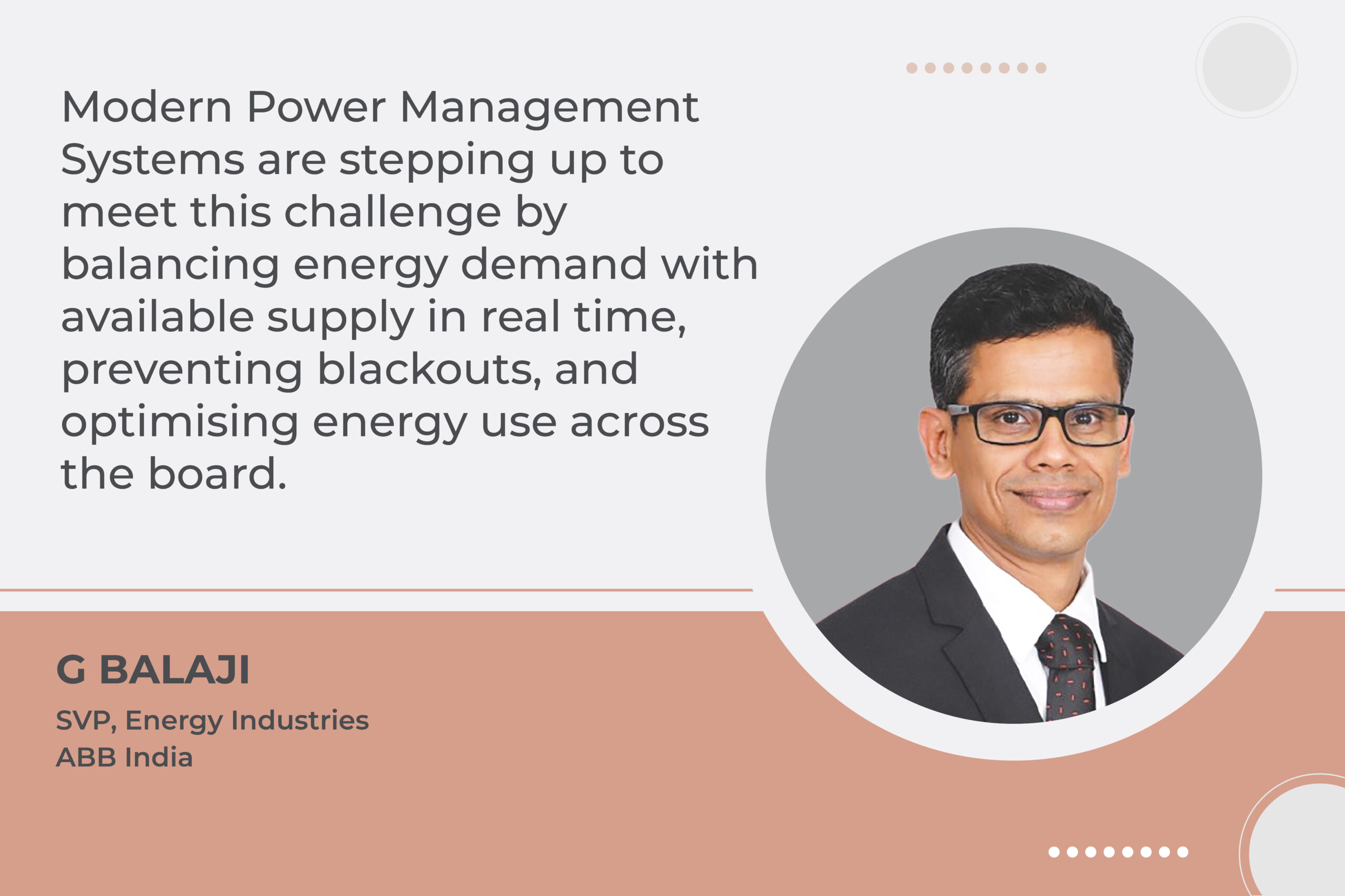ABB Ability™ OPTIMAX helps VPPs for smart trading
By Staff Report September 25, 2025 4:36 pm IST
By Staff Report September 25, 2025 4:36 pm IST

The Automatic Generation Control (AGC) system automatically adjusts the power output of multiple generators to maintain system stability. This maintains the stable frequency of the power grid, preventing fluctuations caused by real-time changes in demand and supply.
AI and automation are redefining grid and plant operations with the decentralisation of energy systems. From real-time load management and virtual power plants to predictive control in hydrogen and bioenergy facilities, intelligent systems enhance stability, safety, and efficiency. This shift enables the deployment of resilient, autonomous, and scalable clean energy across various industries. G Balaji expresses his opinion in talks with EPR.
How do you see the role of AI evolving from support functions to autonomous decision-making in power systems?
As energy systems become more decentralised, AI is becoming a force to be reckoned with in autonomous grid operations. Initially used for support functions such as predictive maintenance and load forecasting, AI is now expanding into roles that require real-time judgment, adaptation, and control. We are seeing the rise of intelligent systems that can autonomously manage grid stability, reroute power during faults, and even orchestrate virtual power plants composed of solar, EVs, and battery storage. Some grid planners are running complex simulations using AI to forecast solar and wind output with unprecedented accuracy. These are not just incremental improvements; they represent a shift in how decisions are made.
The next frontier is agentic AI, systems that not only analyse data but act on it. Imagine a grid that self-heals, balances supply and demand in milliseconds, and learns from every event to improve future performance. Of course, this evolution is not without challenges. Data quality, cybersecurity, and regulatory frameworks must keep pace. But the trajectory is clear: AI is moving from the periphery to the core of power system operations.
What automation technologies are being used to optimise load dispatch centres (LDCs) and reduce grid instability?
Many energy-intensive industries, such as refineries, petrochemical plants, and manufacturing facilities, rely on a reliable and stable power supply to operate their critical operations. Some facilities operate in remote areas where the public grid is patchy or nonexistent, so they rely heavily on their own power generation systems. An unexpected power outage in such facilities can result in significant production losses, which may last for several days. Modern Power Management Systems are stepping up to meet this challenge by balancing energy demand with available supply in real time, preventing blackouts, and optimising energy use across the board.
One standout solution in this space is the ABB Ability™ OPTIMAX, a platform designed for real-time and predictive optimisation of energy assets. It is used to create Virtual Power Plants (VPPs) by aggregating decentralised energy resources, such as solar, wind, CHP (Combined Heat and Power) units, and battery storage, into a single, coordinated system. Optimax enables day-ahead and intra-day scheduling, automatic rescheduling, ancillary service support, and intelligent trading decisions based on AI-powered forecasting.Another critical technology is the Automatic Generation Control (AGC) system, which automatically adjusts the power output of multiple generators. This maintains the stable frequency of the power grid, preventing fluctuations caused by real-time changes in demand and supply. It ensures the reliability and efficiency of the grid, allows for the seamless integration of renewable energy sources like solar and wind, and helps the country achieve its target of high renewable energy capacity by balancing generation and load instantaneously. We have rolled out this solution across more than 100 units in India, utilising the ABB Ability™ Symphony Plus digital control system.
How can automation accelerate the safe deployment of bioenergy and hydrogen-based power systems?
Safety is integral for scaling hydrogen and bioenergy plants, and automation makes it possible to manage that complexity with precision. In hydrogen systems, automation can continuously monitor critical parameters, such as pressure, temperature, and emissions, in real-time. If anything crosses a safety threshold, the system can trigger alerts or even automatic shutdowns, instantly and reliably. With the decentralisation of energy systems, AI is becoming a force to be reckoned with in autonomous grid operations.
In bioenergy plants, where inputs like ethanol and methanol, often derived from crop waste, can vary, predictive automation helps forecast demand and raw material availability. This ensures consistent output and minimises waste. It also reduces manual error by standardising procedures and enabling remote operations, which are valuable in high-risk environments. Digital dashboards and control systems provide operators with comprehensive visibility across the plant, enabling them to make faster and more informed decisions. In a nutshell, automation is not just about efficiency; it is the backbone of safe, scalable, and cost-effective deployment of clean energy systems.
We use cookies to personalize your experience. By continuing to visit this website you agree to our Terms & Conditions, Privacy Policy and Cookie Policy.